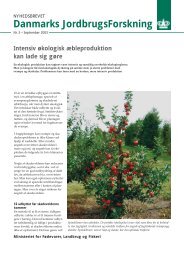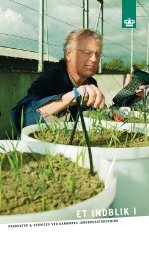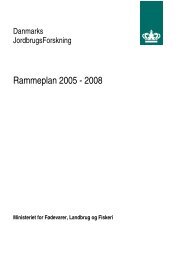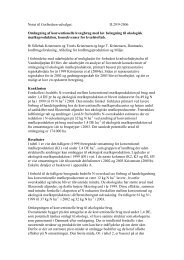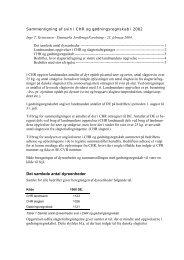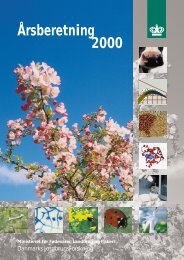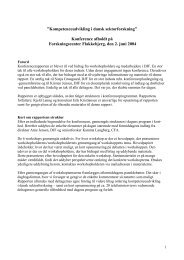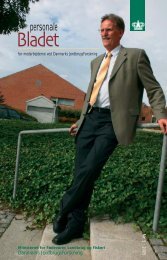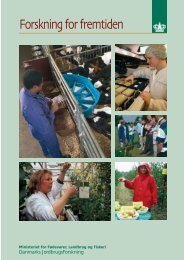Reproduction performances and conditions of group-housed non ...
Reproduction performances and conditions of group-housed non ...
Reproduction performances and conditions of group-housed non ...
You also want an ePaper? Increase the reach of your titles
YUMPU automatically turns print PDFs into web optimized ePapers that Google loves.
- Paper III -<br />
2.2 Registration <strong>of</strong> indicators<br />
2.2.1 Eating behaviour<br />
Although eating speed may differ between sows (Brouns & Edwards, 1994), behavioural<br />
observations <strong>of</strong> time spend eating is likely to give some indications <strong>of</strong> feed intake<br />
(Andersen et al., 1999).<br />
For each F-sow, it was recorded whether the sow was eating or not for each half minute<br />
during feeding. A sow was considered eating if she, while chewing had her snout in the<br />
trough or in contact with the floor (Csermely & Wood-Gush, 1990). However, if the sow<br />
shortly lifted her head from the trough or floor still chewing, she was also considered eating.<br />
The recordings began the moment the feed was supplied <strong>and</strong> stopped 25 minutes (50<br />
recordings) after or until the last sow had stopped eating. Number <strong>of</strong> times the sow was not<br />
eating compared to number <strong>of</strong> recordings (max 50) was calculated for each F-sow (% not<br />
eating).<br />
2.2.2 Back fat depth <strong>and</strong> back fat gain<br />
Measurements <strong>of</strong> back fat depth is a method to assess the body condition <strong>of</strong> sows (Charettte<br />
et al., 1996 fra livestock s. 4) <strong>and</strong> is possible to perform also under practical <strong>conditions</strong><br />
(pers.comm., Maes, 2004).<br />
Back fat depth was measured on the F-sows by means <strong>of</strong> a digital ultrasound back fat indicator<br />
LEAN MEATER ® (Baltic Korn A/S, Naestved, Denmark). All measurements were<br />
performed in the home pen <strong>of</strong> the sow i.e. in a farrowing crate (at weaning <strong>and</strong> at farrowing)<br />
or in a <strong>group</strong> <strong>of</strong> sows (three weeks after mating). The back fat was measured about 65<br />
mm from either side <strong>of</strong> the backbone at the 10 th <strong>and</strong> 12 th (last) rib (conventionally known as<br />
P2-measurements) <strong>and</strong> all three layers <strong>of</strong> fat was measured. Four measurements were performed<br />
in all (two at each rib). The average value <strong>of</strong> the four measurements was used to<br />
characterise the back fat depth <strong>of</strong> the sow. Observations with more than five mm deviations<br />
between the lowest <strong>and</strong> highest measurement were excluded from the material (15 sows).<br />
Back fat gain per day were calculated as the difference between back fat at the beginning <strong>of</strong><br />
the period <strong>and</strong> back fat at the end <strong>of</strong> the period divided with the number <strong>of</strong> days between<br />
the two measurement days.<br />
2.2.3 Fear tests<br />
Three examples <strong>of</strong> fear tests believed to be possible to perform in commercial sow herds<br />
were used in this study. These test are further discussed in Kongsted (2004a).<br />
At weaning, when the F-sows were routinely moved from the service to the pregnancy department,<br />
a human approach test (HA-test) (Rousing et al., 1999; Bonde et al., 2003) was<br />
64




